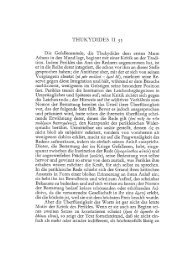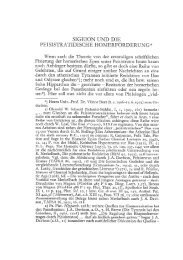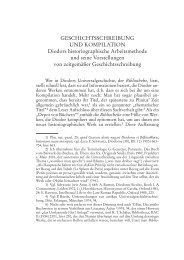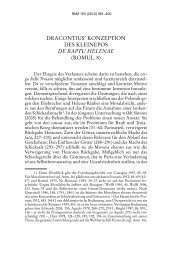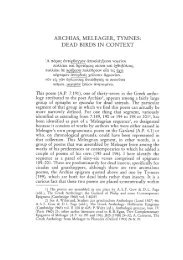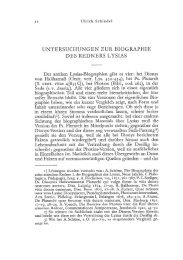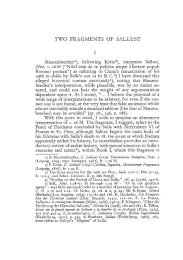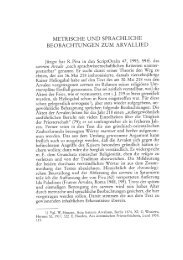THE GEOGRAPHY OF THE PROMETHEUS VINCTUSI
THE GEOGRAPHY OF THE PROMETHEUS VINCTUSI
THE GEOGRAPHY OF THE PROMETHEUS VINCTUSI
You also want an ePaper? Increase the reach of your titles
YUMPU automatically turns print PDFs into web optimized ePapers that Google loves.
<strong>THE</strong> <strong>GEOGRAPHY</strong> <strong>OF</strong> <strong>THE</strong><br />
PROME<strong>THE</strong>US VINCTUS I<br />
1<br />
When 10, transformed into a cow, comes to Prometheus who<br />
is chained, contrary to the common tradition, near the Ocean at<br />
the far north-west limits of the inhabited world, he explains to her<br />
in two successive monologues what route she must take to her<br />
eventual destination in the Egyptian Delta. First she should go east<br />
1) The account of Greek geography given here is strongly influenced by<br />
J. O. Thomson, History of Anciem Geography (Cambridge 1948). Other importam<br />
discussions are those of J. D. P. BolIOn, Aristeas of Proconnesus (Oxford 1962)<br />
46-70; M. Griffith (ed.), Aeschylus. Prometheus Bound (Cambridge 1983);<br />
M. L. West, Studies in Aeschylus (Stuttgart 1990) 304-309. Henceforth, these<br />
works will be cited by the author's name alone.
120 Margalit Finkelberg<br />
along the coast, passing by the inhospitable Scythes and Chalybes,<br />
until she reaches the river Hybristes (705-717); she must not cross<br />
the river until she arrives at its sources in the heights of "Caucasus,"<br />
"the highest of the mountains" (718-721). After crossing<br />
the ridge to the south, she will meet the Amazons who will show<br />
her the way to Lake Maeotis (721-731). She should then cross the<br />
straits dividing Europe from Asia, which from now on will be<br />
called the (Cimmerian) Bosporus (732-735). On entering Asia, she<br />
will proceed to the east and cross a sea (791-792); on her way<br />
further east she will meet first the Phorcides and the Gorgons<br />
inhabiting the plain of Cisthene (792-801), and then the griffins<br />
and the one-eyed Arimaspians dwelling near the sources of the<br />
river Pluto "flowing with gold" (802-806). After this, she will<br />
arrive in a remote land "near the sources of the Sun," which is<br />
inhabited by people of the black race, and where she will find the<br />
river Aethiops (807-809); following this river, she will come to the<br />
sources of the Nile in the Bybline mountains; from there on, she<br />
will go down the Nile until she reaches the Delta, her future horne<br />
(810-815).<br />
It is generally agreed that this geography does not make<br />
sense, and it is not hard to see why. The first and the main difficulty<br />
is the location of the Caucasus to the north of the Black Sea<br />
instead of in its proper place to the east of it. The river Hybristes is<br />
a mystery, and it is not entirely clear what is meant by the sea to<br />
the east of the Pontus (the Caspian?). The rest seems too fanciful<br />
to be taken seriously: the Phorcides, the Gorgons, the griffins, the<br />
one-eyed Arimaspians properly belong to the world of legend, and<br />
it is obvious that the passage from the "river Aethiops" of Asia to<br />
the Nile of Africa cannot correspond to any geographical reality<br />
whatsoever. It is not surprising, then, that both current accounts<br />
of ancient geography and commentaries on the P.V. usually treat<br />
the picture of lo's journey through Europe, Asia and Africa as<br />
sheer poetic liberty on the part of a poet careless of geographical<br />
accuracy2.<br />
Is it however plausible that Aeschylus, or whoever was responsible<br />
for the Prometheus Vinctus, did not realize where the<br />
Caucasus really was? A general idea at least of the direction in<br />
which that range should be looked for must have been present in<br />
Greek popular knowledge from the remotest times, for the simple<br />
2) Thomson 59-60, 82; E. H. Bunbury, AHistory of Ancient Geography, I<br />
(New York 21959) 149-51; Griffith 79-80, 213-14; West 305.
The Geography of the Prometheus Vinctus 123<br />
located in the south of the European continene. Let us suppose<br />
now that the picture of Europe given in the P.V. was set out as a<br />
real description of the continent's geography rather than as a wild<br />
fantasy. With this in view, let us try to answer the following<br />
question: what mountain range of great height lies in the south of<br />
Europe, and what river flowing into the northern ocean takes its<br />
origins in this range? One can hardly avoid the conclusion that the<br />
mountain range would be the Alps and the river the Rhine.<br />
As far as I can see, this conclusion goes weIl with Bolton's<br />
identification of the "Caucasus" of the P.V. with the fabulous<br />
Rhipaean mountains, the seat of the northern wind 8 . Note that the<br />
Rhipaean mountains are the traditional location of the sources of<br />
the Ister 9 , and the sources of the Ister (the Danube) do in fact lie in<br />
the Alps. The blessed folk of the Hyperboreans to whom Apollo<br />
paid regular visits were usually represented as living nearbylO. This<br />
seems to have been the reason why, as actual knowledge of Europe<br />
to the north of the Mediterranean increased, the Rhipaean mountains<br />
together with the Hyperboreans dwelling in them began to<br />
move in a northerly direction, towards still unknown parts of the<br />
world, until eventually they were located near the north pole itself.<br />
However, the sources of the Ister could not be moved as easily as<br />
the Hyperboreans, and the traditional position of these sources in<br />
the Rhipaean mountains is the best proof that the location of the<br />
range in the south of Europe is the original one. It is significant in<br />
this connection that not only are the Rhipaean mountains sometimes<br />
explicitly identified with the Alps!!, but they can also be<br />
regarded as part of the same range as the traditional Caucasus (see<br />
n.6 above).<br />
As for the river Hybristes, its identification with the Rhine<br />
7) And not in its extreme norch as in Bolton's reconstruction, see Bolton<br />
52-53. In general outline, my reconstruction of lo's European route agrees with<br />
that of Griffith, see his map in Griffith vi, and his criticism of Bolton ibid. 217-218<br />
(ad 719-21). Cf. also Thomson 59--60: "The poet Aeschylus takes the wildest<br />
libercies with geography, even putting the Chalybes and the Caucasus vaguely<br />
north-west of the Kerch strait."<br />
8) Bolton 52-53.<br />
9) See Aesch. Fr. 197 Radt apo schol. Ap. Rhod. 4.284; Ap. Rhod. 4.282-87;<br />
cf. Pind. 01. 3.13ff., 8.46ff. and Bolton 52-53.<br />
10) See esp. Pind. 01. 3.13ff.: YAUU'X0XQou 'XOOIlOV EAULUC;, l:OV nOl:E /<br />
'1ol:Qou uno o'XLuQäv / nuyäv EVEL'XEV 'AWPLl:QUWVLOÖUC;, / Ilvällu n1>V OUAU!lJtLm<br />
'XOf"f"Wl:OV MSAWV, / öällOV 'YnEQßoQfWV nELomc; ,Anof,,/AwvoC; SEQonovw AOy<br />
WL; cf. Aesch. Fr. 197 Radt; Ap. Rhod. 4.282-87; schol. Ap. Rhod. 4.284.<br />
11) Posidonius, FGrHist 87 F 103 (= schol. Ap. Rhod. 2.675); Steph. Byz.<br />
S.V. 'YnEQßoQELOL, see furcher Bolton 157 and n.19.
The Geography of the Prometheus Vinctus 125<br />
from the Alps to the Sea of Azov the poet of the P.V. was foIlowing<br />
some already established geographical conception. As it happens,<br />
the earliest source in which this conception is explicitly attested<br />
belongs to the fourth century B.C<br />
II<br />
It seems to me that many problems in the geography of the<br />
P.V. can be solved if we abandon the presumption that the map of<br />
the world as found in Prometheus' instructions to 10 reflects the<br />
geograrhical knowledge and theory of the fifth-century B.C or<br />
even 0 a some earlier period 16 . Consider, for example, its idea of<br />
Scythia as spreading up to the far north-west of Europe (709ff.).<br />
This idea is in sharp contrast to the archaic and classical one as<br />
represented, for example, in Herodotus, who unambiguously defines<br />
Scythia as lying between the Don and the Danube, that is, to<br />
the north of Lake Maeotis. As for the regions to the north-west,<br />
both the early historians and the poetic tradition that preceded<br />
them seem to have been hardly aware of their existence 17 .<br />
Let us consider now Diodorus' account of an unorthodox<br />
version of the Argonauts' journey back from the Pontus as given<br />
by Timaeus of Tauromenium (second half of the fourth - first half<br />
of the third century B.C): "Not a few both of the ancient [historians]<br />
and of the later ones as weIl, one of whom is Timaeus, say<br />
that the Argonauts ... sailed ... up the Tanais river as far as its<br />
sources, and at a certain place they hauled the ship overland, and<br />
foIlowing in turn another river which flowed into the ocean they<br />
sailed down it to the sea; then they made their course from the<br />
north to the west, keeping the land on the left, and when they<br />
arrived near Gadeira they sailed into our sea."18 It can be seen<br />
16) The latter view was advocated by Bolton 63-64, who sought to reduce<br />
the map of the world suggested by the P.V. to the Arimaspea of Aristeas of<br />
Proconnesus, that is, to the seventh century B.C.; this bias made him deny, contrary<br />
to historical evidence (cf. nn. 3--4 above), any Greek knowledge of the Pontus<br />
prior to Aristeas and even cast doubt on the traditional version of the Argonautic<br />
legend which, as pointed out above, presupposes such knowledge from the earliest<br />
times of Greek history.<br />
17) See Hdt. 4.17-20; 47-58; 99-117; cf. Thomson 60-61. Note that the<br />
barbarian peoples that lived beyond the Scythians are described by Herodotus as<br />
spreading directly to their north and not to the north-west as in later sourees.<br />
18) Diod. Sie. 4.56.3 (= FGrHist 566 F 85); trans. by C.H. Oldfather. Cf.<br />
Scymnus apo schol. Ap. Rhod. 4.282-91.
126 Margalit Finkelberg<br />
from this account that the route of the Argonauts as represented in<br />
this version is essentially that proposed to 10 in the P.V. The only<br />
difference is that of direction: 10 starts from the ocean at the<br />
extreme north-west of Europe, proceeds east along the coast until<br />
she reaches a great river, goes up this river southwards as far as its<br />
sources, and eventually arrives at Lake Maeotis, whereas the Argonauts<br />
start from Lake Maeotis, sail up the Tanais as far as its<br />
sources, pass overland to a river which flows into the ocean and<br />
eventually find themselves in the ocean at the extreme north-west<br />
of Europe 19 .<br />
At the same time, it is actually out of the question that<br />
Timaeus' picture of West Europe can be an independent one, and<br />
not only because Diodorus explicitly remarks that Timaeus was<br />
not the first to introduce it. As is weIl known, this historian was<br />
notorious for not being in the habit of basing his geographical<br />
accounts on the firsthand knowledge of his own 20 , and it goes<br />
without saying that his geography of Europe, not founded as it is<br />
on any established literary tradition, must have included a considerable<br />
element of firsthand knowledge of the continent. It is indeed<br />
reasonable to suppose that updating of the map of Europe<br />
went hand-in-hand with the expansion of practical knowledge of<br />
the continent's geography. Note that Timaeus introduced his version<br />
of the return of the Argonauts through Central and Northern<br />
Europe only to disqualify the alternative one, according to which<br />
they returned to the Mediterranean through an additional, nonexistent,<br />
branch of the Ister, which was supposed to empty into<br />
the Adriatic. Diodorus comments on this view: "For time has<br />
refuted those who assumed that the Ister which empties by several<br />
mouths into the Pontus and the Ister which issues into the Adriatic<br />
flow from the same regions. As a matter of fact, when the Romans<br />
subdued the nations of the Istrians it was discovered that the latter<br />
river has its sources only forty stades from the sea."21 In view of<br />
this, it is reasonable to suggest that Timaeus' alternative solution to<br />
the problem of the Argonauts' return was also based on some new<br />
information deriving from firsthand knowledge of the geography<br />
19) If we take into aeeount the tradition plaeing the sourees of the Tanais in<br />
the Rhipaean mountains (Mela 1.115; Pliny, N.H. 4.78; Luean 3.272f.; Orosius<br />
1.2.4; Dion. Periegetes 663 H.; cf. Bolton 52-53), it would be plausible to suggest<br />
that this was the plaee where the Argonauts were supposed to have hauled their<br />
ship overland.<br />
20) See Polyb. Book 12 passim, esp. frr. 25e.7, 25h.1, 27.1-3, 28.6, 28a.7.<br />
21) Diod. Sie. 4.56.8; cf. Strabo 1.3.15 p.57C.
132 Margalit Finkelberg<br />
east, we can suggest this as the reason why Prometheus was transferred<br />
from his usuallocation in the east to the far north-west of<br />
the world 39 •<br />
At the same time, these horizons were short-lived. The picture<br />
of the world as found in the P.V. was soon superseded by a<br />
new bulk of geographical information which began to be accumulated<br />
from the end of the fourth century. In the east, Alexander's<br />
expeditions proved some of the earlier suppositions unwarranted,<br />
notably that of aland-bridge between India and Libya; in the west,<br />
increasing contacts with Rome led to a much more accurate knowledge<br />
of the European continent to the north of the Mediterranean<br />
40 • This is why both Ctesias and especially Pytheas ceased to<br />
be regarded as serious geographers in later generations. It should<br />
not be forgotten, however, that Pytheas' was the geography with<br />
which Timaeus worked, and that Aristotle leaned heavily on the<br />
information found in Ctesias. We can see now that the same can be<br />
said of the author of the geographical sketch of the P.V.<br />
III<br />
As far as I can see, it is unlikely that the above arguments in<br />
favour of a fourth-century date for Prometheus' instructions to 10<br />
have any bearing on the much-vexed question of the authenticity<br />
of the P.V. Even when the Prometheus Vinctus is not recognized as<br />
belonging to Aeschylus, scholars unequivocally place it in the fifth<br />
39) Ir seems that Prometheus' position was generally regarded as symbolic<br />
of the end of the earth, cf. his removal to the Indian Caucasus after the latter had<br />
become known to the Greeks (see n. 5 above). As far as the Prometheus of the P.V.<br />
is concerned, it is possible that the steep rock above the northern ocean to which he<br />
is chained can be traced to "some northern colurnn at the end of the world" ("w;<br />
lloxul:T) 0l:11A.T) ßaQELOt;) described in Ps.-Scymn. 188-95; cf. its further description<br />
at 11. 189-90: EOl:L Ö' u'VT)A.T] ltUVU ett; KU!lUl:WÖEt; ltEA.UYOt; aVatELVoUO' iiKQUV.<br />
(According to Thomson 89, this is a borrowing from the account of Europe given<br />
by the fourth-century historian Ephorus.) This column seems to have marked the<br />
northern boundary of the earth, see further C. Müller's commentary ad locum in<br />
Geographi Graeci minores i 211-212. Ir is not out of the question that Herculis<br />
columnae whose existence at approximately the same place is reported by Tacitus in<br />
Germany 34 mayaiso be relevant in this connection.<br />
40) Cf. Strabo 1.2.1 p. 14C.: "For Alexander opened up for us geographers a<br />
great part of Asia and all the northern part of Europe as far as the Ister River; the<br />
Romans have made known all the western part of Europe as far as the river Albis<br />
[Eibe] (which divides Germany into two parts), and the regions beyond the Ister as<br />
far as the Tyras [Dniester] River ..." Cf. also Polyb. 3.59.
The Geography of the Prometheus Vinctus 139<br />
delayed by lo's reminiscence of her past history up to her leaving<br />
Argos, and by abrief lyric song expressing the Chorus' sympathy<br />
with lo's sufferings (631-695). When this digression is over, Prometheus<br />
sets out to deliver the story of the end of lo's troubles as<br />
requested (696-706); in order to prove the reliability of his account,<br />
he begins with the description of lo's past wanderings from<br />
the moment she left Argos (the point at which her narrative stopped)<br />
and up to her arrival beside the lonic Sea (824-843). The<br />
stichomythia that follows (743-787) skillfully blends lo's fate with<br />
that of Prometheus: Prometheus will be delivered from his sufferings<br />
by one of lo's descendants. In conclusion, in an account<br />
which not only answers both lo's request and that of the Chorus<br />
but is also important in the general perspective of the Prometheus<br />
trilogy (844-876), Prometheus teIls about lo's future arrival in<br />
Egypt, about her giving birth to Epaphus, and about Epaphus'<br />
descendants up to Heracles, his future deliverer.<br />
Prometheus' accounts of lo's future wanderings in Europe<br />
(707-741) and Asia (788-818) drop out of this sequence. We saw<br />
indeed that the first of them is inappropriate in that it is introduced<br />
after Prometheus' promise to tell 10 about the end of her journey,<br />
and the second in that it is redundant as regards Prometheus'<br />
concluding narrative of lo's future in Egypt. It seems to be more<br />
than a mere coincidence that these are precisely the passages conspicuous<br />
by the high rate of resolution and first-foot anapaests and<br />
by such metrical and other anomalies as I enumerated above. As<br />
distinct from this, the two accounts of lo's past, by 10 herself<br />
(640-686) and by Prometheus (824-843), are freefrom resolution<br />
and the other metrical peculiarities characterizing Prometheus' descriptions<br />
of Europe and Asia (with the sole exception of resolution<br />
occurring in a geographical name at 1. 840, see n. 49). The<br />
same, however, cannot be said of Prometheus' second account of<br />
Egypt, which ends with his revealing the identity of his deliverer<br />
(844-74): although it seems to be firmly rooted within the original<br />
sequence of the Prometheus-Io scene as suggested above, this passage<br />
contains the same rate of resolution as Prometheus' description<br />
of Asia in 11. 788-818 (see above).<br />
Note now that there are passages in Prometheus' instructions<br />
to 10 which can be interpreted to the effect that their author worked<br />
with an earlier and a more traditional version of the story. It is<br />
likely indeed that the Chalybes, the Amazons, Themiscyra and the<br />
Thermodon, whose proper place is to the south of the Black Sea,<br />
were more or less mechanically transferred from this earlier ver-
140 Margalit Finkelberg<br />
sion into the presem one. The misplacing of Salmydessus at 11.<br />
725-27 seems to be especiaBy symptomatic. Indeed, the poet's<br />
memioning of this town, located in Europe not far from the Thracian<br />
Bosporus, as being in the same area as Themiscyra strongly<br />
suggests that the original version of the P.V. took 10 to the<br />
Caucasus through the Thracian Bosporus and the southern shore<br />
of the Black Sea. Furthermore, whether it was the Thracian or the<br />
Cimmerian Bosporus that 10 was supposed to cross in the original<br />
version (ApoBodorus 2.1.3 makes her cross both), in so far as<br />
Prometheus was represented as chained to the conventional<br />
Caucasus she should have been able to do this only before and not<br />
after her meeting with hirn. In other words, it is likely that lo's<br />
crossing of the Bosporus was evoked in Prometheus' account of<br />
her past wanderings, maybe the very one that is found in P.V.<br />
829-41. There, Prometheus' enumeration of the earlier stages of<br />
lo's journey ends with the aition for the lonian Sea. It is not out of<br />
the question, then, that it was continued by lo's crossing of the<br />
Bosporus and yet another aition. In that case, Prometheus'<br />
prophecies about lo's future should have concerned mainly her<br />
traditional route from Colchis to Egypt and the destiny of her<br />
descendants; in view of the aforesaid, it can be suggested that it<br />
was supplamed by 844"':'74 in order to bring it into correspondence<br />
with the tragedy's new concept of lo's Asian route.<br />
To sum up, the disagreemem between Prometheus Vinctus<br />
and Prometheus Lyomenos as to the place of Prometheus' punishmem,<br />
the tragedy's two alternative geographies, its failure to make<br />
the unconventional place of Prometheus' punishmem an organic<br />
part of the play, and the lack of unity by which its third epeisodion<br />
is characterized seem to be the main reasons which make it difficult,<br />
if not impossible, to draw a coherem picture of the tragedy<br />
and of the Prometheus trilogy in general. In the last analysis, aB<br />
the difficulties in question reside in that part of the tragedy that<br />
deals with Prometheus' instructions to 10: if we remove these<br />
instructions, there would be no discrepancy between the two<br />
Prometheus plays, no difficulties in the tragedy's first stasimon, no<br />
mistake in the hypothesis, no "loss of coherence and unity" in the<br />
10 scene. This seems to justify the conclusion that the geographical<br />
sketch of the P.V. is a late interpolation purporting to bring the<br />
original geography of the tragedy up to date.<br />
We saw that the geographical sketch of the P.V. is peculiarly<br />
consistent both where it does make sense (first of aB, in the geography<br />
of Europe) and where it does not (in the geography of Asia).
The Geography of the Prometheus Vinctus 141<br />
In order to place it in time, we have to construe aperiod in which<br />
the mythological geography of western Europe began to be supplanted<br />
by the realone, whereas the geography of Asia still remained<br />
fabulous. It seems that the span of time in which the<br />
journey of Pytheas had already become a matter of common<br />
knowledge while the campaigns of Alexander had not, was exactly<br />
such aperiod. Since the theory of aland-bridge and the view of the<br />
Caspian as an inland sea became obsolete by the beginning of the<br />
third century, and since Pytheas' account of West Europe is tentatively<br />
situated around 320 B.C.55, we can assume the end of the<br />
fourth century B.C. as a likely date of the geographical sketch of<br />
the P.V. 56 .<br />
Tel-Aviv Margalit Finkelberg<br />
55) See Thomson 127-29 (the Caspian), 82 (the land-bridge), 143 (Pytheas).<br />
On Pytheas' date see also F. Lasserre, Pytheas (4), KlPauly IV (1972) 1272-1274.<br />
56) On a similar case of geographicalinterpolation in Euripides see A. Dihle,<br />
Der Prolog der "Bacchen" und die antike Uberlieferungsphase des Euripides-Textes<br />
(Heidelberg 1981).




